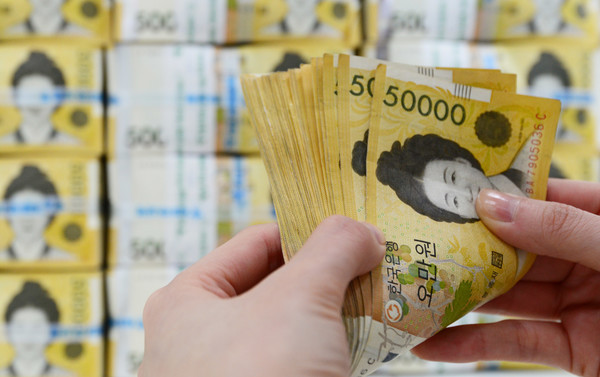 |
(Yonhap) |
South Korea’s money supply gained a record amount of currency and other liquid instruments on-year in December, central bank data showed Wednesday, triggering alarm bells about inflation.
The country’s M2 amounted to 3,191.3 trillion won ($2.9 trillion) as of end-December, gaining 260.9 trillion won on-year, showed preliminary data compiled by the Bank of Korea. In terms of percentiles, the M2 increased 9.8 percent on-year and 0.4 percent on-month. The M2 is a calculation of the money supply that includes cash, checking deposits and easily convertible near money.
The sharp increase in the money supply often translates into an abrupt surge in liquidity in the market amid times of financial crisis. In 2008, due to the increased risks from the global financial crisis, the M2 increased 14.2 percent on-year, while the figure gained 10.3 percent the following year.
The strong momentum observed in the surging money supply in December was due to large household and corporate loans extended by the banks here, the BOK said.
Korean banks’ household and corporate loans have been growing at a fast pace since the outbreak of the COVID-19 pandemic here early last year. Outstanding bank loans to local households gained 100.5 trillion won on-year to 988.8 trillion won as of end-December, earlier data from the BOK showed. Outstanding corporate loans, meanwhile, gained 107.4 trillion won in the same period to 976.4 trillion won, making the largest on-year gains since 2009.
Key factors have been the BOK’s decision to slash its benchmark interest rate to a record-low 0.5 percent in May last year and the government’s ongoing loan deferment program for local businesses financially hit by the pandemic. The government on Tuesday asked major banking groups to extend the program -- which was slated to end by end-March -- by another six months.
The snowballing momentum of growth in the M2 is fueling concerns about inflation, which could be a problem if the money supply grows faster than the economic output under “normal economic circumstances.”
The fact that global demand is returning to normal is intensifying those concerns, but local experts are leaning toward projections of “disinflation” or “reflation” for Asia’s fourth-largest economy. Disinflation is basically a slowdown in the rate of increase of the general price level of goods and services in a nation’s economy, while “reflation” is the first phase of economic recovery after a period of contraction.
“In 2020, lackluster demand, a drop in global oil prices and government welfare policies pulled down the prices, but in 2021, it is likely to move in the opposite direction,” BOK Gov. Lee Ju-yeol said in December.
“It would be a deflation if the prices of commodities and services decline, but it is likely to go up in 2021, but not to the point where the economy would have to worry about a surge in inflation,” he added.
By Jung Min-kyung (
mkjung@heraldcorp.com)








